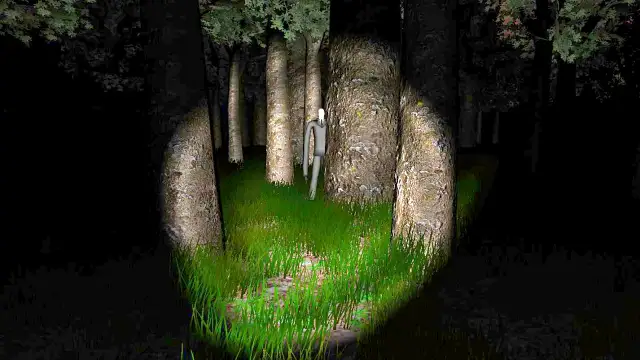Have you ever heard of Slender Man? This eerie figure became a sensation in 2012, especially among teenagers. The game based on him is filled with jump scares that can give you chills. Many say it’s fun, but it can also make your heart race!
In the game, players must collect eight pages hidden in a dark forest. But beware! Slender Man is always watching. As you gather pages, he gets closer, and the suspenseful music heightens the tension. The thrill of the chase keeps players on edge.
Who is Slender Man?
According to an article by Jen McEntire, titled “Urban Legends: The Terrible Legend of Slender Man,” this character is described as a tall, thin figure. He stands between 6 to 7 feet tall, with some claiming he could be as much as 15 feet! Slender Man is faceless and wears a black suit. His arms are unnaturally long, stretching up to 34 feet, allowing him to capture his victims easily.
Slender Man is said to target children aged 16 and younger. Some stories even suggest he commits horrific acts against them. He has the power to control people and is often depicted with long tentacles. If he catches you, the tales say you might wake up tied in a place where he has killed before. He will then ask you a question. Answer correctly, and he will break your limbs. Answer incorrectly, and he will reach into your neck to get your heart.

The Origins of Slender Man
The legend of Slender Man has roots in various folklore. One chilling story involves a man who was brutally killed. He was beaten, stabbed, and hung from a tree. His limbs were pulled from their sockets, leading to his transformation into the Slender Man we know today.
During the day, Slender Man is said to appear in wooded areas. At night, he might show up in dark rooms, open windows, or even in crowds. Some tales suggest he can be seen with attractive women, adding to the mystery. This is a good reason to keep your doors and windows locked at night!
A Haunting Folktale
In her article, McEntire also shares a Romanian folktale about twin sisters named Sorina and Stela. Their mother led them into the woods, where they encountered Slender Man, who appeared as a nobleman. His arms were described as long and snake-like.
Under Slender Man’s influence, the mother ordered Stela to draw a circle in the dirt and have Sorina lie in it to be sacrificed. Stela refused and ran home. When their father returned, Stela told him what happened. Later, she heard a knock at the door. A voice claimed to be her father, but she refused to open it. The voice then claimed to be her mother. When she opened the door, she saw her mother holding Sorina’s severed head and her father’s head in the other hand. The mother chillingly stated, “There is no reward for goodness in this world.” After that, Slender Man killed Stela.
This story illustrates how Slender Man can manipulate humans and highlights his terrifying nature.

Signs of Slender Man’s Presence
According to TheLost, there are signs that Slender Man may be coming for you. These include:
- Coughing up blood
- Technology malfunctioning
- Memory loss
- Hallucinations
- Nightmares about Slender Man
- Drawing a symbol (a circle with an “X” through it)
- Diarrhea
- Vomiting
Children are said to be able to see Slender Man, while adults cannot. Before disappearing, children often have dreams about him. He seems to befriend them before taking them away.
Slender Man’s Traits
Slender Man exhibits several traits:
- He shows interest in victims for unknown reasons.
- If the victim is a child, he may present himself as friendly.
- He eventually stalks adults, particularly those who have experienced significant trauma.
- For adults, he may cause “Slender sickness,” leading to paranoia, nosebleeds, and hallucinations.
- Victims are often abducted to nearby forests, where they meet a gruesome fate.
In extreme cases, Slender Man may destroy evidence of his existence by setting fire to homes, workplaces, or schools. Victims may die in bizarre ways, such as being impaled on tree branches while still alive. Their organs are removed and placed in plastic bags, then returned to their bodies without any signs of struggle.
The Slender Man Phenomenon
There are numerous videos and footage claiming to show Slender Man stalking and attacking people. One notable series is Marble Hornets, which documents the experiences of a person being followed by Slender Man. These videos add to the legend’s mystique, blurring the lines between reality and fiction. Viewers are left questioning what is real and what is merely a product of imagination.
The Impact of Slender Man on Culture
The Slender Man legend has had a significant impact on popular culture. It has inspired countless memes, fan art, and even movies. The character has become a symbol of modern horror, representing our fears of the unknown. The internet has played a crucial role in spreading the legend, allowing it to evolve and adapt over time.
In 2014, the Slender Man mythos took a dark turn when two young girls in Wisconsin attempted to murder a classmate, claiming they did it to appease Slender Man. This shocking incident brought national attention to the legend and raised questions about the influence of online content on young minds. It sparked debates about the responsibilities of creators and the potential dangers of fictional horror stories.
Why Do We Love Scary Stories?
So, why do we find ourselves drawn to stories like Slender Man? There are several reasons:
- Adrenaline Rush: Scary stories provide a thrill. The fear and suspense can be exhilarating, giving us a rush of adrenaline without real danger.
- Exploration of Fears: Horror stories allow us to confront our fears in a safe environment. They help us explore the darker aspects of human nature and the unknown.
- Community and Connection: Sharing scary stories can create a sense of community. Fans of horror often bond over their shared interests, discussing theories and experiences.
- Cultural Reflection: Urban legends like Slender Man reflect societal fears and anxieties. They often address themes of isolation, technology, and the loss of innocence.
How to Stay Safe from Urban Legends
While Slender Man is a fictional character, the stories surrounding him can evoke real fear. Here are some tips to stay safe and grounded:
- Educate Yourself: Understanding the origins and context of urban legends can help you separate fact from fiction. Researching the stories can demystify them.
- Limit Exposure: If you find that horror stories or games affect your mental health, consider limiting your exposure. It’s okay to step back from content that makes you uncomfortable.
- Talk About Your Fears: Sharing your feelings with friends or family can help alleviate fear. Discussing urban legends can also lead to interesting conversations and insights.
- Focus on Reality: Remember that these stories are fictional. While they can be entertaining, they do not reflect real-life dangers.
Conclusion: The Enduring Allure of Slender Man
In conclusion, Slender Man is more than just a creepy character in a game. He represents a modern urban legend that has captured the imagination of many. The stories surrounding him tap into our deepest fears and anxieties, making them both fascinating and terrifying.
As we navigate the world of urban legends, it’s essential to approach them with a critical mind. While they can be entertaining, they also remind us of the power of storytelling and the impact it can have on our lives. So, the next time you hear a tale about Slender Man or any other urban legend, take a moment to reflect on its origins and what it means to you.
FAQs:
What is Slender Man?
Slender Man is a fictional character that originated as an internet meme. He is depicted as a tall, faceless figure in a black suit who stalks and abducts children.
Is Slender Man real?
No, Slender Man is a fictional character created for entertainment purposes. However, his legend has influenced real-life events and discussions about horror culture.
Why do people believe in urban legends?
Urban legends often contain elements of truth or are based on real events, making them more believable. They also tap into our fears and emotions.
How can I protect myself from urban legends?
Educate yourself about the stories, limit your exposure to scary content, and talk about your fears with others to gain perspective.
What impact did Slender Man have on society?
The Slender Man legend has sparked discussions about the influence of online content on youth and the responsibilities of creators in horror storytelling.
Are there any movies about Slender Man?
Yes, there are several films inspired by the Slender Man legend, including a 2018 horror film titled “Slender Man.”
How did Slender Man become popular?
Slender Man gained popularity through internet memes, games, and videos, particularly on platforms like YouTube and Reddit.
What are some signs that Slender Man is near?
According to the legend, signs include coughing up blood, technology malfunctions, memory loss, and nightmares about him.
What are some other popular urban legends?
Other well-known urban legends include “The Hookman,” “The Chupacabra,” and “The Vanishing Hitchhiker.”
How can urban legends influence behavior?
Urban legends can shape our perceptions of safety and risk, leading to changes in behavior, such as avoiding certain places or being cautious about technology.
Are there any real-life cases linked to Slender Man?
Yes, the tragic case of two girls attacking a classmate in 2014 brought significant media attention to the Slender Man legend and raised concerns about the impact of online content on youth.
What role does social media play in spreading urban legends?
Social media allows for rapid sharing and adaptation of urban legends, making it easier for them to reach a wider audience and evolve over time.
Can urban legends be used in educational settings?
Yes, urban legends can be used to teach critical thinking, storytelling, and cultural studies, helping students analyze the impact of folklore on society.
Final Thoughts on Slender Man
As we conclude our exploration of Slender Man, it’s clear that this urban legend has left a significant mark on popular culture. From video games to movies, the character continues to evolve, captivating audiences with his eerie presence.
While Slender Man may be a fictional creation, the emotions and discussions he inspires are very real. As we share these stories, we connect with one another, exploring the darker corners of our imaginations.
So, the next time you hear a tale about Slender Man or any other urban legend, take a moment to reflect on its origins and implications. These stories remind us of the power of fear, the thrill of the unknown, and the importance of community in sharing our experiences.


